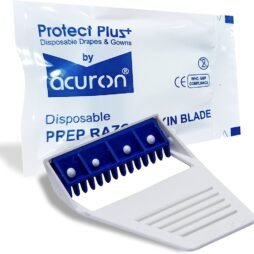Shoe covers, also known as booties or shoe protectors, are protective garments designed to cover and shield footwear, primarily in healthcare, cleanroom environments, laboratories, and various other settings where maintaining cleanliness, hygiene, and contamination control is essential. Here’s a description of shoe covers:
Description of Shoe Covers:
Shoe covers are typically made of disposable materials like non-woven fabric, polyethylene, or similar materials. They are designed to be worn over regular shoes or boots to serve several important functions:
1. Contamination Control: Shoe covers act as a barrier between the shoes and the environment, preventing the transfer of dirt, dust, pathogens, or other contaminants from footwear to clean or sterile areas. They are especially critical in healthcare settings, cleanrooms, laboratories, and food preparation areas to maintain a sanitary environment.
2. Infection Control: In healthcare facilities, shoe covers are used as a part of infection control measures. They help reduce the risk of healthcare-associated infections by minimizing the spread of pathogens carried on shoes, ensuring that healthcare workers do not inadvertently transport germs from one patient’s room to another.
3. Protection Against Fluids: Shoe covers can provide a level of protection against spills, splashes, and bodily fluids in healthcare and laboratory settings. They help keep shoes dry and prevent the spread of potentially infectious substances.
4. Cleanroom Use: In cleanrooms used for manufacturing sensitive electronic components or pharmaceuticals, shoe covers are essential to prevent the introduction of particles and contaminants from footwear that could compromise the quality of the products being produced.
5. Dust and Dirt Control: Shoe covers are useful in construction sites, laboratories, and other industrial settings to keep dirt, dust, and debris from being tracked indoors, maintaining a cleaner and safer work environment.
Key features of shoe covers often include:
- Elastic cuffs or openings that secure them around the ankles, preventing them from slipping off during use.
- Non-skid soles to reduce the risk of slipping, especially on smooth or wet surfaces.
- Disposable or reusable options, with disposable shoe covers being more common in healthcare settings due to their convenience and hygiene benefits.
Applications:
Shoe covers find applications in a wide range of industries and settings, including:
- Healthcare: Hospitals, clinics, and healthcare facilities to maintain a sterile environment and minimize cross-contamination.
- Laboratories: Research laboratories, pharmaceutical manufacturing, and cleanrooms to prevent the introduction of contaminants.
- Food Service: In food processing plants and kitchens to meet hygiene and sanitation standards.
- Construction: Construction sites to keep work areas clean and reduce the tracking of mud and debris.
- Real Estate and Home Inspections: Professionals entering homes or properties to avoid damaging floors and spreading dirt.






